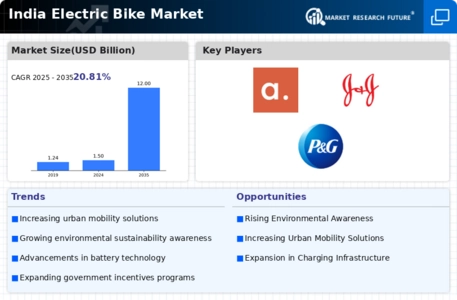Market Trends
Key Emerging Trends in the India Electric Bike Market
The market trends for electric bikes in India have witnessed a remarkable upswing in recent years, reflecting a shift in consumer preferences towards sustainable and energy-efficient transportation solutions. Electric bikes, also known as e-bikes, have gained popularity across various demographic segments in the country, driven by factors such as environmental consciousness, rising fuel costs, and the government's push towards electric mobility.
One of the prominent trends in the Indian electric bike market is the increasing adoption among urban commuters. With congested city roads and a growing awareness of environmental issues, many commuters are turning to electric bikes as a practical and eco-friendly alternative to traditional petrol-powered two-wheelers. The ease of maneuverability, cost-effectiveness, and the ability to navigate through traffic make electric bikes an attractive option for daily commuting.
Affordability plays a crucial role in shaping the market trends for electric bikes in India. The government's initiatives and subsidies aimed at promoting electric vehicles, including bikes, have significantly reduced the upfront cost for consumers. This has made electric bikes more accessible to a broader spectrum of the population, including students, working professionals, and individuals from various income groups, fostering increased adoption across the country.
The electric bike market in India is witnessing a surge in innovation and product diversity. Both established manufacturers and startups are introducing a range of electric bike models with varying features, designs, and performance capabilities. From stylish and sporty electric scooters to electric bicycles with pedal-assist technology, consumers now have a plethora of options to choose from, catering to different preferences and usage scenarios.
Government policies and incentives are playing a pivotal role in driving the market trends for electric bikes. Various states in India have implemented subsidies, tax benefits, and other incentives to encourage the adoption of electric two-wheelers. Additionally, the central government's FAME (Faster Adoption and Manufacturing of Hybrid and Electric Vehicles) scheme aims to further boost the electric mobility sector by providing financial support and incentives for manufacturers and consumers.
The integration of advanced battery technology is a significant trend shaping the electric bike market in India. With improvements in battery efficiency and energy density, electric bikes are experiencing enhanced performance and extended ranges. This addresses one of the primary concerns of potential buyers regarding the limitations of electric vehicles in terms of distance coverage. The evolution of battery technology is contributing to the overall appeal and practicality of electric bikes for everyday use.
Infrastructure development for electric bikes is gaining momentum across urban centers in India. Cities are witnessing the establishment of dedicated charging stations, making it more convenient for electric bike users to recharge their vehicles. The growing charging infrastructure is alleviating concerns related to "range anxiety," making electric bikes a more feasible option for those considering a switch from traditional fuel-powered bikes.
The market trends for electric bikes also indicate a shift in consumer perception and preferences. Electric bikes are no longer viewed solely as an eco-friendly choice but are increasingly seen as a practical and efficient mode of transportation. As awareness grows and the advantages of electric bikes become more evident, the market is expected to witness continued expansion and acceptance.
The market trends for electric bikes in India showcase a dynamic and promising landscape. The convergence of affordability, government support, product innovation, and infrastructure development is propelling the growth of the electric bike sector. As more consumers recognize the benefits of electric bikes for their daily commuting needs, the market is poised for further expansion, contributing to a greener and more sustainable future for urban mobility in India.






Leave a Comment